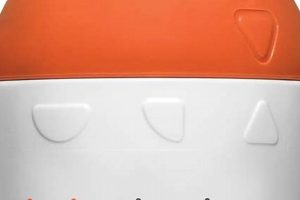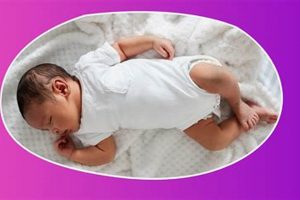Selecting appropriate nighttime attire for infants, excluding wearable blankets, focuses on ensuring thermal comfort and safety. This involves layering clothing items that are breathable and non-restrictive, allowing for natural movement while maintaining a consistent body temperature throughout the night. For example, a cotton onesie paired with lightweight pants can provide sufficient warmth in moderate room temperatures.
Maintaining an appropriate sleep environment for an infant is paramount for both safety and promoting restful sleep. Historically, parents have relied on various methods to regulate a baby’s temperature during sleep, ranging from swaddling to simply adding or removing layers of blankets. Today, the emphasis is on minimizing potential hazards, such as loose bedding, while ensuring the child remains comfortably warm to facilitate healthy sleep patterns.
The subsequent sections will delve into specific clothing recommendations based on room temperature, address essential safety considerations, and offer guidance on identifying signs of overheating or being too cold. These factors are vital for ensuring an infant’s well-being during sleep when alternatives to wearable blankets are chosen.
Guidance on Dressing Infants for Sleep Without Wearable Blankets
The following provides practical advice for selecting appropriate sleepwear for infants, ensuring comfort and safety when a wearable blanket is not utilized.
Tip 1: Determine Room Temperature: Accurately gauge the room’s temperature using a reliable thermometer. This is crucial for selecting appropriate clothing layers.
Tip 2: Choose Breathable Fabrics: Opt for natural, breathable fabrics such as cotton or merino wool. These materials help regulate body temperature and minimize the risk of overheating.
Tip 3: Layer Strategically: Implement a layering system. A base layer, such as a cotton onesie, can be augmented with additional layers like lightweight pants or a long-sleeved shirt, depending on the room temperature.
Tip 4: Avoid Overdressing: Refrain from overdressing. Infants can overheat easily. A general guideline is to dress the baby in one layer more than an adult would wear in the same environment.
Tip 5: Monitor for Signs of Discomfort: Regularly check the infant for signs of overheating (sweating, flushed skin, rapid breathing) or being too cold (cold extremities, shivering).
Tip 6: Ensure Proper Fit: Choose clothing that fits appropriately. Avoid items that are too loose, which could pose a suffocation hazard, or too tight, which could restrict movement and circulation.
Tip 7: Consider Footed Pajamas: Footed pajamas can provide added warmth for the feet, particularly in cooler environments, and eliminate the need for socks that can easily be kicked off.
Adhering to these recommendations promotes a secure and comfortable sleep environment, facilitating optimal rest for the infant.
The subsequent section will address potential challenges and solutions related to maintaining a consistent sleep temperature for infants.
1. Room Temperature
Room temperature serves as a critical determinant in selecting appropriate sleepwear for infants, particularly when wearable blankets are not used. The ambient temperature of the sleep environment directly influences the layers and type of clothing required to maintain thermal comfort and prevent overheating or chilling.
- Metabolic Rate and Thermoregulation
Infants possess a higher metabolic rate relative to their body size, and their thermoregulatory mechanisms are not fully developed. This physiological reality necessitates careful management of their sleep environment to avoid temperature-related stress. A room that is too warm can lead to overheating, increasing the risk of Sudden Infant Death Syndrome (SIDS), while a room that is too cool can cause the infant to expend unnecessary energy to maintain body temperature, potentially disrupting sleep.
- Clothing Layers as Temperature Regulation
The number and type of clothing layers worn by the infant function as a primary means of regulating body temperature in the absence of a wearable blanket. In warmer room temperatures (e.g., 24-26C or 75-79F), a single layer of breathable fabric, such as a cotton onesie, may suffice. In cooler environments (e.g., 18-20C or 64-68F), multiple layers, including a long-sleeved undershirt and footed pajamas, may be necessary to provide adequate insulation.
- Monitoring and Adjustment
Continuous monitoring of the infant’s temperature is crucial. Signs of overheating include flushed skin, rapid breathing, and sweating. Conversely, cold extremities or shivering indicate that the infant is too cold. Adjustments to clothing layers should be made based on these observations. It is advisable to check the infant’s chest or back for warmth rather than relying solely on the temperature of their hands or feet.
- Environmental Control Considerations
Factors beyond simply reading a thermometer can influence the effective room temperature. Air circulation, humidity levels, and proximity to windows or external walls can all impact the perceived temperature. Blankets near the crib might also affect the temperature. In addition, the thermostat setting may need to be adjusted in advance so it will affect the room during the night. Strategies to mitigate these variables include using a fan to improve air circulation, a humidifier to regulate humidity, and ensuring the crib is located away from drafts or direct sunlight.
The interplay between room temperature and the infant’s clothing is dynamic and requires attentive observation. By understanding the nuances of infant thermoregulation and adjusting clothing layers accordingly, caregivers can create a safe and comfortable sleep environment, even when wearable blankets are not employed. Consistent monitoring and responsiveness to the infant’s cues are essential for maintaining thermal equilibrium and promoting restful sleep.
2. Breathable Fabrics
The selection of breathable fabrics is paramount when considering infant sleepwear, particularly when wearable blankets are not utilized. The intrinsic properties of materials such as cotton, merino wool, and bamboo directly influence an infant’s ability to regulate body temperature, thereby affecting overall comfort and safety during sleep. A causal relationship exists between fabric breathability and the risk of overheating. Non-breathable materials impede the evaporation of perspiration, potentially leading to hyperthermia, a known risk factor for Sudden Infant Death Syndrome (SIDS).
As an essential component of suitable infant sleep attire, breathable fabrics facilitate air circulation, allowing the infant’s skin to remain dry and cool. This is crucial considering infants have less developed thermoregulatory systems compared to adults. For instance, a study comparing cotton and synthetic fabrics revealed significantly lower skin temperatures in infants wearing cotton garments. Conversely, infants dressed in synthetic materials exhibited elevated skin temperatures, indicating reduced heat dissipation. The practical significance of this understanding lies in the ability to make informed decisions about clothing choices, thereby mitigating potential health risks. Imagine a scenario where an infant, dressed in non-breathable synthetic pajamas, is placed in a room with slightly elevated temperature; the restricted airflow could quickly lead to overheating and associated discomfort.
In summary, breathable fabrics are not merely a desirable feature but a necessity when dressing infants for sleep without wearable blankets. Understanding the interplay between fabric properties, infant physiology, and environmental conditions is essential for promoting safe and restful sleep. Challenges remain in educating caregivers about the subtle differences between fabric types and the long-term benefits of choosing natural, breathable options. Addressing these challenges through clear and accessible information can significantly impact infant health outcomes.
3. Layering approach
The implementation of a layering approach to infant sleepwear, when wearable blankets are not utilized, offers a versatile method for adjusting to fluctuating ambient temperatures. This strategy hinges on the understanding that multiple thin layers provide superior insulation and temperature regulation compared to a single bulky garment.
- Adaptability to Temperature Variations
Layering permits dynamic adjustments in response to changing room temperatures. A base layer, such as a cotton onesie, can be supplemented with additional layers like a lightweight sleep sack or footed pajamas as needed. If the room temperature decreases during the night, an extra layer can be added; conversely, layers can be removed to prevent overheating.
- Facilitating Moisture Management
Multiple layers composed of breathable fabrics, such as merino wool or cotton, aid in wicking moisture away from the infant’s skin. This is particularly important during sleep, as infants may perspire, leading to discomfort and potential chilling. By facilitating evaporation, layering helps maintain a stable core temperature and reduces the risk of skin irritation.
- Customization for Individual Needs
Each infant possesses unique thermoregulatory characteristics. A layering system allows for customization based on the infant’s individual needs and preferences. Some infants may require more layers than others to maintain a comfortable temperature. Careful observation and responsiveness to the infant’s cues are essential for determining the appropriate level of layering.
- Enhancing Safety Considerations
While layering offers thermoregulatory benefits, safety must remain paramount. Avoid excessively thick or bulky layers that could restrict movement or pose a suffocation hazard. All garments should fit snugly but not tightly, and caregivers should consistently monitor the infant for signs of overheating or chilling. Loose blankets or bedding must remain absent from the sleep environment. To ensure comfort, one can choose to combine layers such as a cotton onesie with a light sleep sack or long-sleeved shirt paired with lightweight pants as it adapts according to temperature changes.
The practice of layering infant sleepwear, when foregoing wearable blankets, necessitates a balanced approach that prioritizes adaptability, moisture management, individual needs, and, above all, safety. Attentive observation and informed garment selection are crucial for optimizing infant comfort and minimizing potential risks.
4. Proper fit
When selecting infant sleepwear as an alternative to wearable blankets, proper fit assumes critical importance. Garments that are either excessively loose or unduly tight present distinct hazards that undermine the safety and comfort of the infant. Loose clothing poses a suffocation risk; fabric can inadvertently cover the infant’s face, obstructing breathing. Conversely, overly restrictive garments can impede circulation, potentially leading to discomfort and disrupting sleep patterns. Furthermore, ill-fitting attire may limit freedom of movement, impacting the infants ability to reposition, possibly contributing to positional asphyxia. Practical significance is highlighted in cases where loose pajama tops have ridden up during sleep, covering the infant’s mouth and nose, necessitating immediate intervention. Therefore, a snug, yet unrestricted fit becomes a foundational element.
The correlation between proper fit and safe sleep practices extends beyond immediate physical risks. Appropriately sized garments are less likely to bunch or twist during sleep, minimizing pressure points and promoting even weight distribution. This factor is particularly relevant for infants with conditions such as torticollis or plagiocephaly, where sustained pressure on specific areas of the head or neck should be avoided. For example, well-fitting sleepwear minimizes the risk of exacerbating these conditions during prolonged sleep periods. Additionally, the choice of design plays a role; garments with enclosed feet should allow adequate room for toe movement to prevent discomfort or restriction of blood flow.
In summary, the pursuit of appropriate infant sleep attire, excluding wearable blankets, necessitates rigorous attention to garment fit. The benefits extend beyond mere comfort, directly impacting the infants safety and overall well-being. By selecting sleepwear that conforms to established sizing guidelines, parents can mitigate potential hazards associated with loose or restrictive clothing, thereby promoting a secure and restful sleep environment. Challenges persist in effectively communicating these nuances to caregivers and ensuring consistent adherence to safety recommendations.
5. Safety guidelines
Adherence to established safety guidelines is paramount when determining appropriate infant sleepwear, especially when forgoing the use of wearable blankets. Deviation from these guidelines can elevate the risk of preventable adverse events, underscoring the need for meticulous compliance.
- Avoiding Overheating
Infants are particularly vulnerable to overheating due to their immature thermoregulatory systems. Safety guidelines stipulate avoiding overdressing. Symptoms such as sweating, flushed skin, and rapid breathing indicate potential overheating, necessitating immediate adjustment of clothing layers. Maintaining a room temperature within the recommended range of 68-72F (20-22C) is also crucial.
- Preventing Suffocation Hazards
Loose bedding, including blankets, pillows, and stuffed animals, poses a significant suffocation risk. Safety guidelines mandate a bare crib environment, free from such items. Additionally, clothing with loose ribbons, strings, or buttons should be avoided, as these can detach and present choking hazards.
- Ensuring Proper Fit
Sleepwear should fit snugly but not tightly. Overly loose garments can ride up and cover the infant’s face, obstructing breathing. Restrictive clothing can impede circulation and restrict movement. Following manufacturer sizing guidelines and regularly assessing the fit of sleepwear are essential.
- Back Sleeping Position
While not directly related to clothing, the back-sleeping position is a critical component of safe sleep practices. Infants should be placed on their backs to sleep, regardless of the type of sleepwear used. This position reduces the risk of Sudden Infant Death Syndrome (SIDS) and is consistently emphasized in safety guidelines.
These facets of safety guidelines collectively contribute to minimizing risks associated with infant sleep, especially when wearable blankets are not utilized. By adhering to these recommendations, caregivers can create a safer sleep environment, promoting restful and secure sleep for infants.
6. Monitoring cues
Effective observation of an infant’s physiological and behavioral signals constitutes a crucial component in ensuring safe and comfortable sleep, particularly when wearable blankets are not used. Attentive monitoring allows for informed adjustments to clothing and the sleep environment, mitigating the risks of overheating or chilling.
- Skin Temperature Assessment
Evaluation of skin temperature provides direct insight into the infant’s thermal status. A warm chest or back suggests an appropriate temperature, whereas cool extremities may indicate the need for additional layers. Conversely, a hot or sweaty back warrants immediate removal of clothing to prevent hyperthermia. This assessment should be conducted regularly, especially during the initial stages of sleep.
- Respiratory Rate and Pattern Analysis
Alterations in respiratory rate or pattern can signify thermal distress. Rapid breathing may indicate overheating, while shallow or labored breathing could suggest the infant is too cold. Observing chest rise and fall, along with noting any signs of nasal flaring or retractions, provides valuable information about the infant’s comfort level and potential need for intervention in clothing or room temperature.
- Behavioral Indicators
Changes in behavior often precede pronounced physiological signs of thermal discomfort. Restlessness, fussiness, or excessive crying may indicate that the infant is either too hot or too cold. Conversely, a comfortable infant typically exhibits relaxed posture and consistent sleep patterns. Paying attention to these behavioral cues allows for preemptive adjustments to the sleep environment, mitigating potential distress.
- Visual Inspection for Signs of Distress
Visual examination for physical signs of thermal discomfort complements tactile and behavioral assessments. Flushed skin suggests overheating, while pale or mottled skin may indicate chilling. Additionally, noting the presence of perspiration or shivering provides direct evidence of the infant’s thermal state. These observations should be integrated with other monitoring cues for a comprehensive understanding of the infant’s comfort level.
The consistent and informed interpretation of these monitoring cues enables caregivers to maintain optimal thermal comfort for infants sleeping without wearable blankets. Integrating these observations into a holistic approach to infant sleep promotes safety and restful sleep.
Frequently Asked Questions
The following addresses common inquiries regarding appropriate sleep attire for infants when wearable blankets are not utilized.
Question 1: What constitutes an appropriate room temperature for infant sleep without a sleep sack?
The recommended room temperature ranges from 68 to 72 degrees Fahrenheit (20 to 22 degrees Celsius). Maintaining a consistent temperature within this range minimizes the risk of overheating or chilling.
Question 2: Which fabrics are most suitable for infant sleepwear when a sleep sack is not used?
Breathable, natural fabrics such as cotton, merino wool, and bamboo are preferred. These materials facilitate air circulation and help regulate body temperature.
Question 3: How many layers of clothing are typically necessary for infant sleep without a sleep sack?
The number of layers depends on the room temperature. A general guideline is to dress the infant in one layer more than what an adult would wear in the same environment. Adjustments should be made based on individual needs and monitoring for signs of discomfort.
Question 4: What are the key indicators of overheating in an infant during sleep?
Signs of overheating include flushed skin, rapid breathing, sweating, and restlessness. Immediate removal of clothing layers is necessary if these symptoms are observed.
Question 5: How can suffocation hazards be minimized when selecting infant sleepwear without a sleep sack?
Choose snug-fitting garments that are not overly loose. Avoid clothing with ribbons, strings, or buttons that could detach and pose a choking hazard. A bare crib environment, free from blankets, pillows, and stuffed animals, is essential.
Question 6: Is it necessary to use socks or footed pajamas when a sleep sack is not used?
The necessity of socks or footed pajamas depends on the room temperature and the infant’s individual needs. In cooler environments, these items can provide added warmth. Ensure that socks are not too tight and that footed pajamas allow adequate room for toe movement.
Careful consideration of these factors ensures a secure and comfortable sleep environment for infants when wearable blankets are not employed.
The following will address the importance of seeking professional medical advice.
Conclusion
The preceding discussion has explored considerations relevant to how to dress baby for sleep without sleep sack. Emphasis has been placed on establishing thermal comfort and prioritizing safety through careful selection of breathable fabrics, strategic layering, attention to proper fit, and diligent monitoring for signs of distress. The absence of wearable blankets necessitates heightened vigilance in maintaining an appropriate sleep environment.
Caregivers are encouraged to consistently implement the discussed strategies and to remain informed about evolving recommendations regarding infant sleep safety. The well-being of the infant remains paramount, and proactive measures are essential for promoting restful and secure sleep. If questions or concerns persist, consultation with a qualified healthcare professional is strongly advised to ensure individualized and evidence-based guidance.







